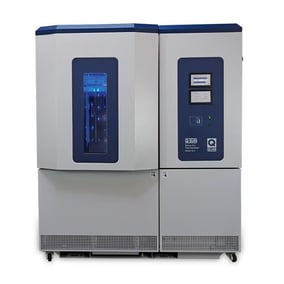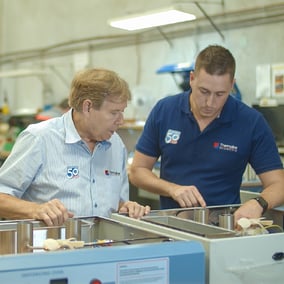
These devices are crucial in maintaining quality, safety, and compliance in fields such as food and beverage, pharmaceuticals, environmental monitoring, and manufacturing. By providing accurate and continuous temperature data, temperature data loggers help ensure optimal conditions, prevent spoilage, and support regulatory compliance.
What Is a Temperature Data Logger?
A temperature data logger is a compact electronic device designed to record temperature over a specified period. Equipped with sensors, data loggers collect and store temperature readings at regular intervals, which can later be retrieved and analysed.
Types of Temperature Data Loggers
- Standalone Data Loggers: Self-contained units that store data internally and require manual download.
- Wireless Data Loggers: Transmit data wirelessly to a central system for real-time monitoring.
- USB Data Loggers: Feature a USB interface for easy data transfer to computers.
- Bluetooth-enabled Data Loggers: Allow for wireless data retrieval and interaction via smartphones and tablets.
Key Features and Capabilities
Temperature data loggers vary in features, including:
- High precision and accuracy
- Wide measurement ranges
- Large data storage capacities
- Long battery life
- Various connectivity options (USB, Bluetooth, Wi-Fi)
Applications of Temperature Data Loggers
Food and Beverage Industry
Temperature data loggers are vital in monitoring storage and transportation conditions, ensuring food safety, and complying with health regulations.
- Food Temperature Monitoring
- Housing and Business Premises
- Indoor Air Quality
- Museums and Exhibitions
Pharmaceutical and Healthcare Sector
In this sector, maintaining the correct temperature for vaccines, medications, and biological samples is crucial. Data loggers help ensure products remain effective and safe.
- Blood Storage
- Medical and Healthcare Equipment
- Pharmaceutical Cold Chain
- Vaccine Storage
- Veterinary and Animal Welfare
- 21CFR Compliant Data Loggers
Environmental Monitoring
Data loggers are used to track environmental conditions in greenhouses, weather stations, and wildlife habitats, and they help monitor and protect ecosystems.
Manufacturing and Production
Monitoring temperature in manufacturing processes ensures product quality and consistency, preventing defects and spoilage.
- Industrial Equipment
- HVAC
- Marine
- Automotive
- Test and Measurement
- Scientific Equipment
Research and Development
In research and development, temperature data loggers support experiments and product development by providing precise environmental data.
- Energy Management Equipment
- HVAC
- Outside Environmental Data
- PLC / HMI / Data Acquisition
- Process Control and Automation

How Does a Temperature Data Logger Work?
Sensors and Data Recording
Temperature data loggers use built-in sensors to measure temperature. These sensors convert temperature into electronic signals that the logger records at set intervals.
Data Storage and Retrieval
Data loggers store temperature readings internally, which can be retrieved via USB, Bluetooth, or wireless connections, depending on the model.
Software Interfaces and Data Visualisation
Most data loggers come with software that allows users to download, view, and analyse the collected data. These interfaces often include tools for graphing, statistical analysis, and report generation.
Choosing the Right Temperature Data Logger
Factors to Consider
- Accuracy and Precision: Ensure the logger meets the required measurement standards.
- Measurement Range: Choose a logger that covers the expected temperature range.
- Data Storage Capacity: Ensure sufficient memory for the logging duration.
- Battery Life: Consider how long the logger needs to operate without recharging.
- Connectivity Options: Select based on how you plan to retrieve and monitor data.
Comparison of Popular Models
Research and compare models based on the above factors to find the best fit for your application. Popular brands include HOBO, Testo, and Lascar.
Setting Up a Temperature Data Logger
Initial Setup and Calibration
- Follow the manufacturer's instructions for setup.
- Calibrate the logger to ensure accurate readings.
Placement and Installation Tips
- Position the logger where it can accurately measure the target environment.
- Avoid placing it near heat sources or in direct sunlight.
Configuring Data Logging Intervals
Set the logging intervals based on the monitoring needs. Shorter intervals provide more detailed data but use more memory and battery.
Using a Temperature Data Logger
Step-by-Step Guide to Deploying the Logger
- Power on the logger and configure settings.
- Place the logger in the desired location.
- Start the logging process.
Ensuring Proper Data Collection
- Regularly check the logger to ensure it's functioning correctly.
- Replace batteries or recharge as needed.
Troubleshooting Common Issues
- Refer to the manual for troubleshooting tips.
- Contact the manufacturer for support if needed.

Analysing and Interpreting Data
Downloading and Exporting Data
- Connect the logger to a computer or use wireless options to download data.
- Export data in compatible formats (e.g., CSV, Excel).
Data Analysis Tools and Software
- Use the provided software to analyse and visualise the data.
- Look for patterns, trends, and anomalies.
Interpreting Results and Making Informed Decisions
- Use the data to assess environmental conditions.
- Make adjustments to processes or storage conditions based on findings.
Best Practices for Temperature Data Logging
Regular Calibration and Maintenance
- Periodically calibrate the logger to maintain accuracy.
- Perform regular maintenance as recommended by the manufacturer.
Ensuring Data Integrity
- Regularly download and back up data to prevent loss.
- Protect the logger from damage and environmental hazards.
Compliance with Industry Standards and Regulations
- Ensure that logging practices meet industry-specific standards and regulations.
- Keep detailed records to support compliance and audits.
For a seamless and convenient shopping experience, we recommend purchasing your temperature data logger from Thermoline through our trusted online partner site, Labdirect.
With an easy-to-navigate interface and secure payment options, Labdirect offers a wide selection of data loggers to meet your specific needs.
Whether you require a standalone logger, a wireless option for real-time monitoring, or a Bluetooth-enabled device for easy data retrieval, Labdirect has you covered.
Temperature data loggers are indispensable tools for monitoring and maintaining optimal conditions across various industries. By understanding how to choose, set up, and use these devices, you can ensure accurate temperature monitoring and make data-driven decisions to enhance quality and safety.






